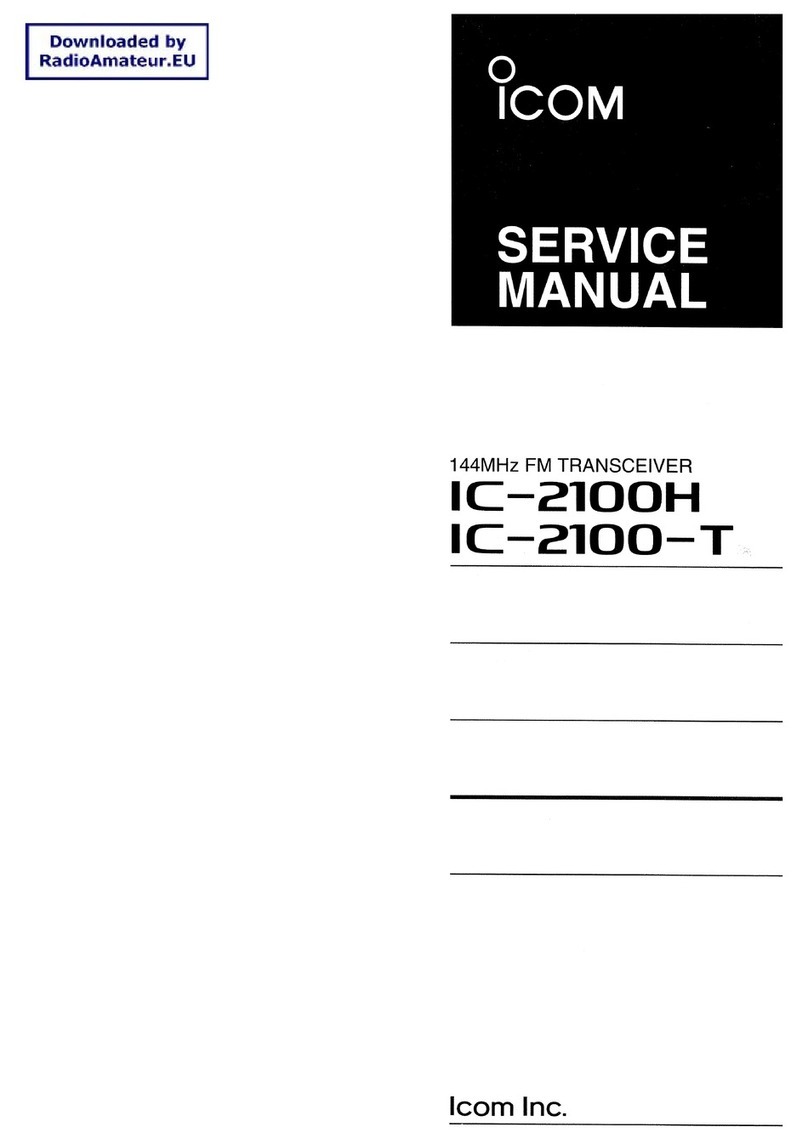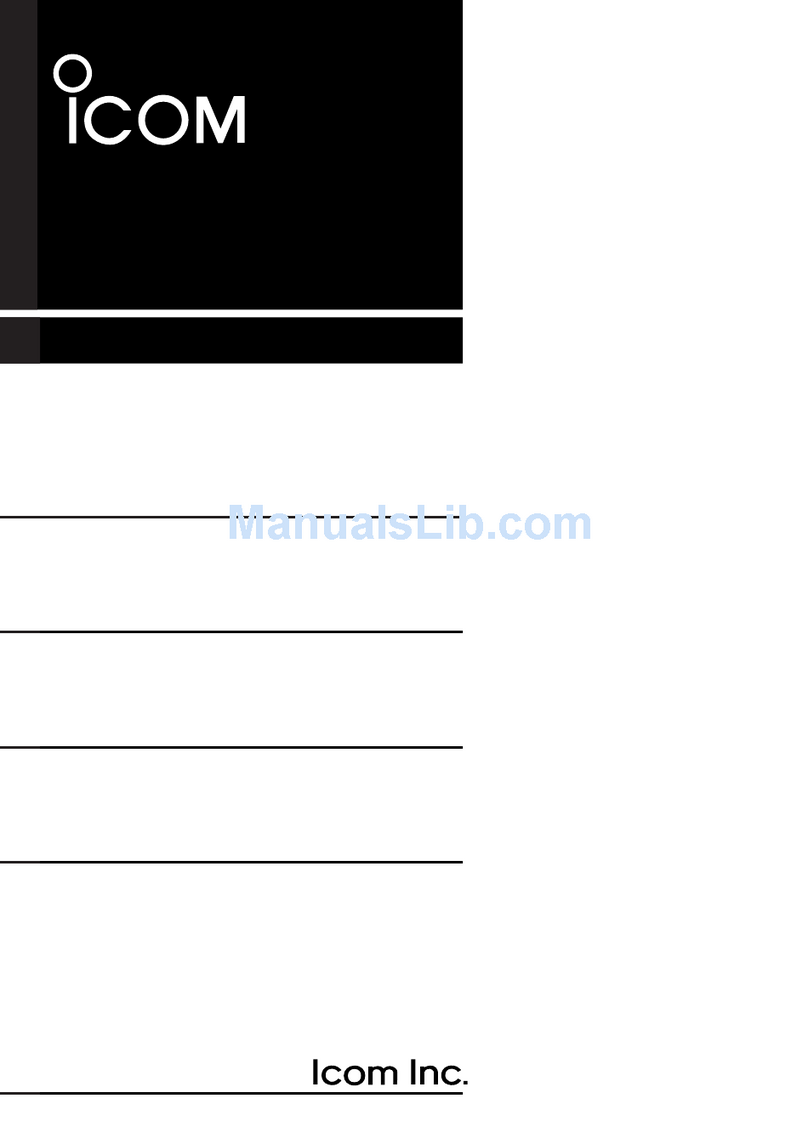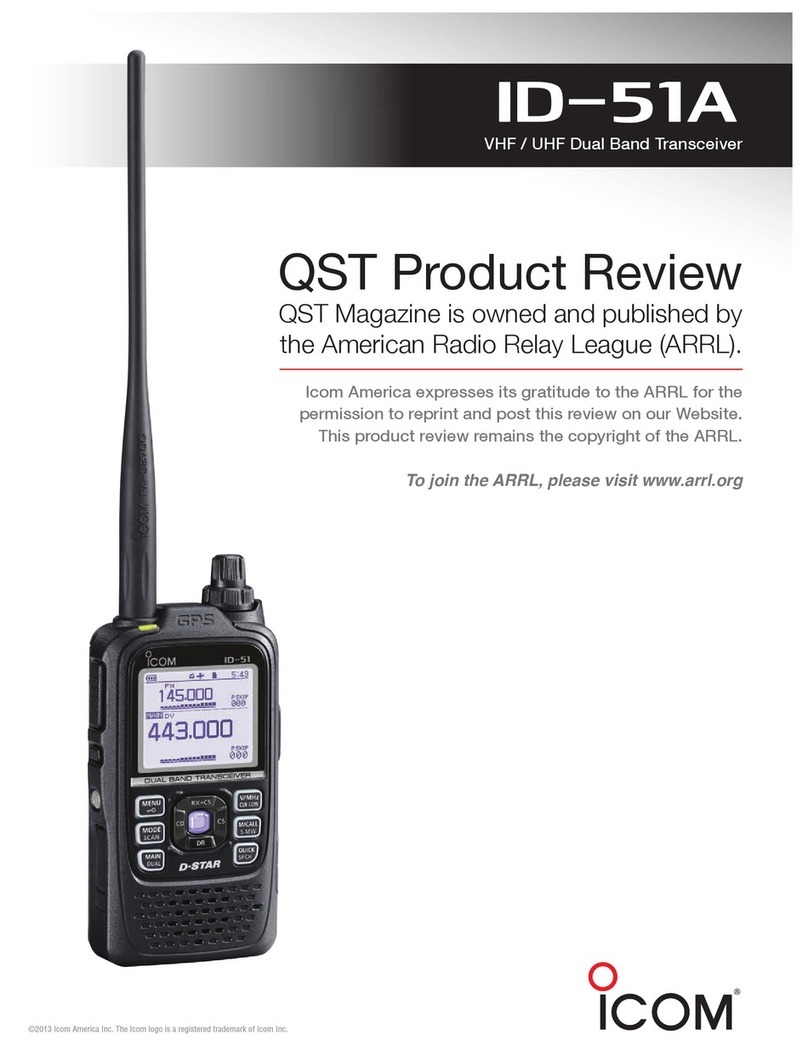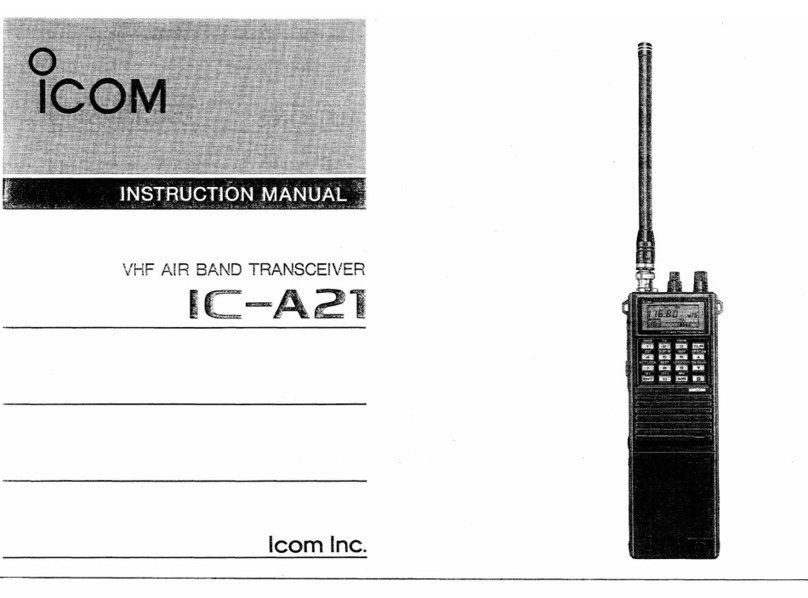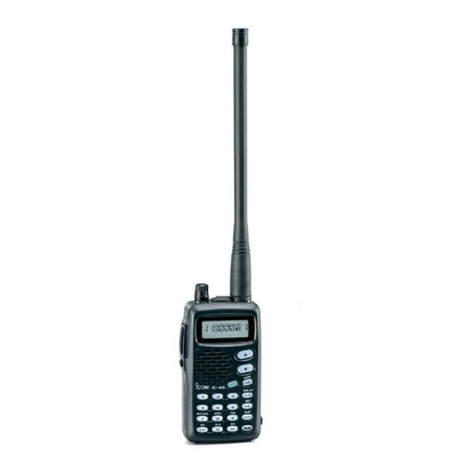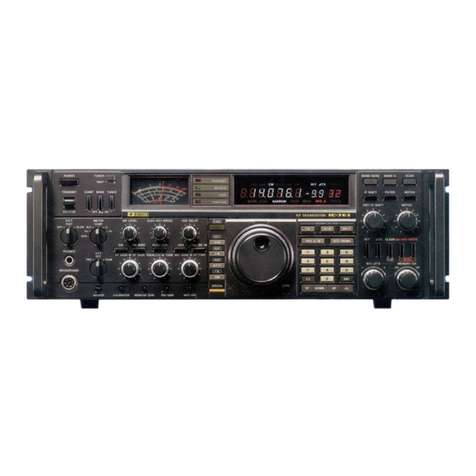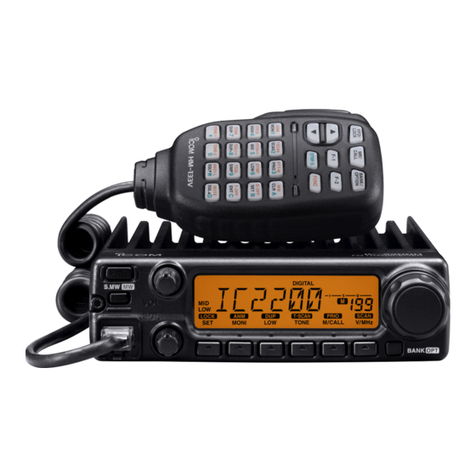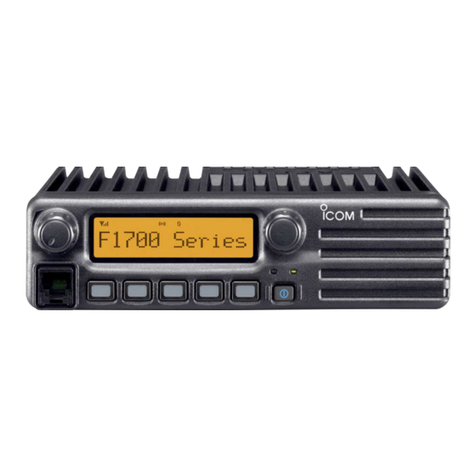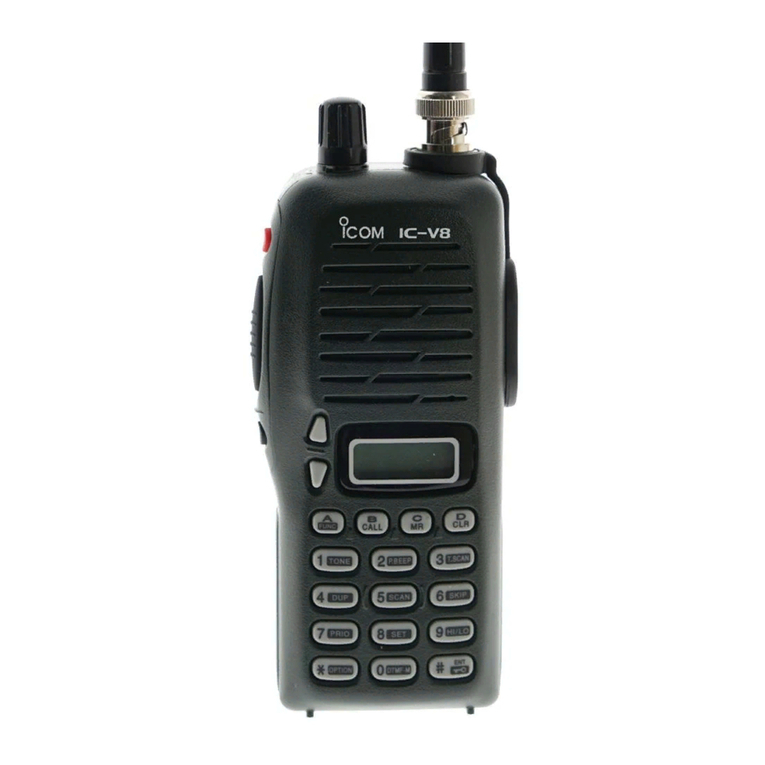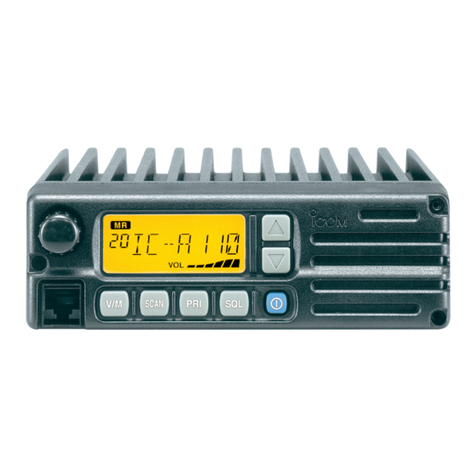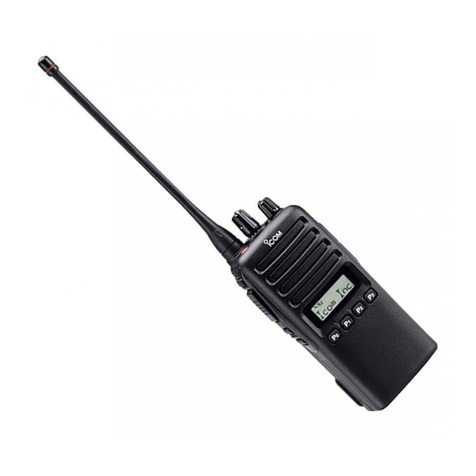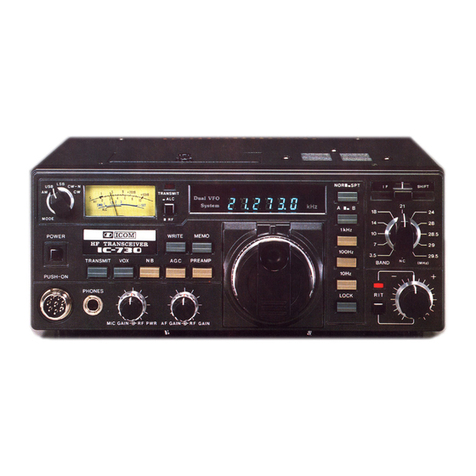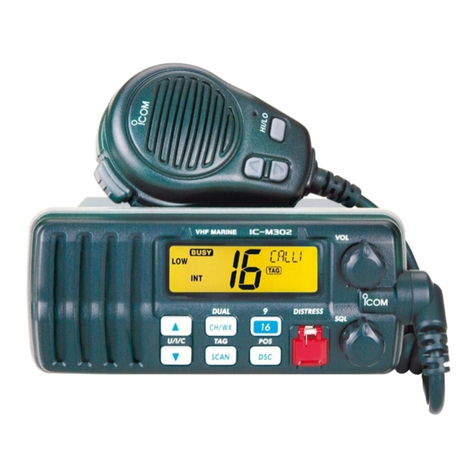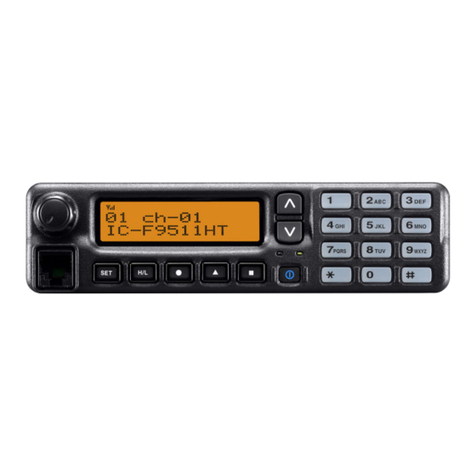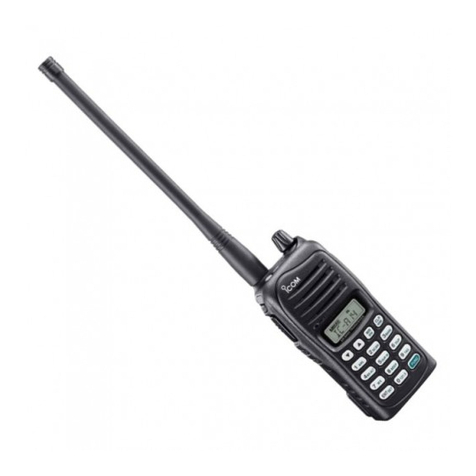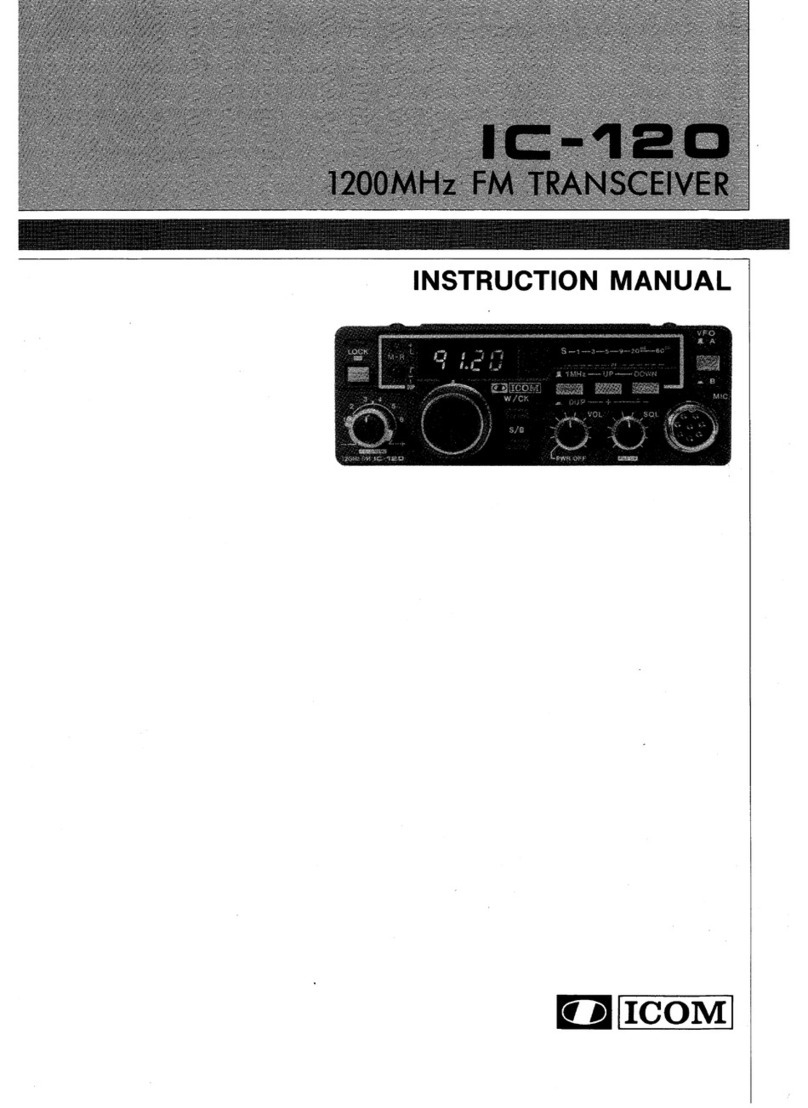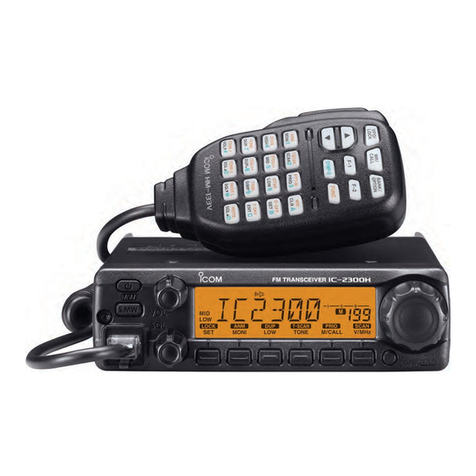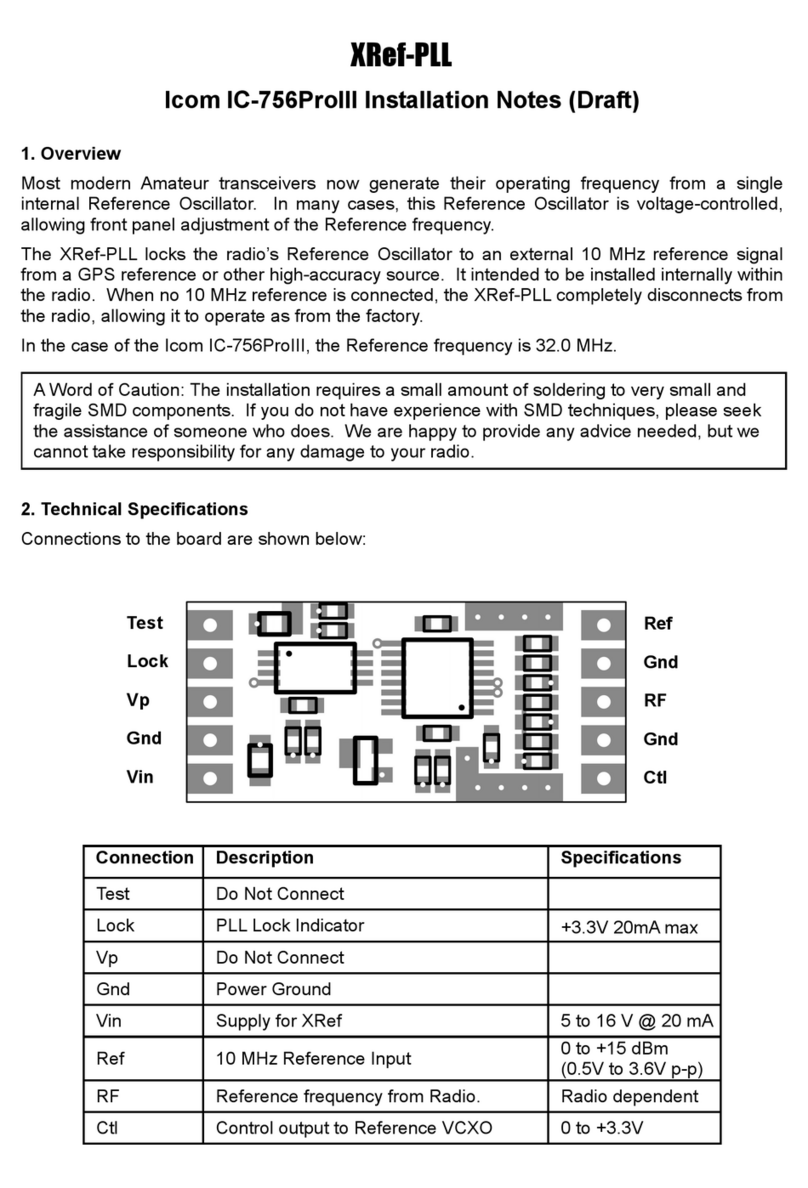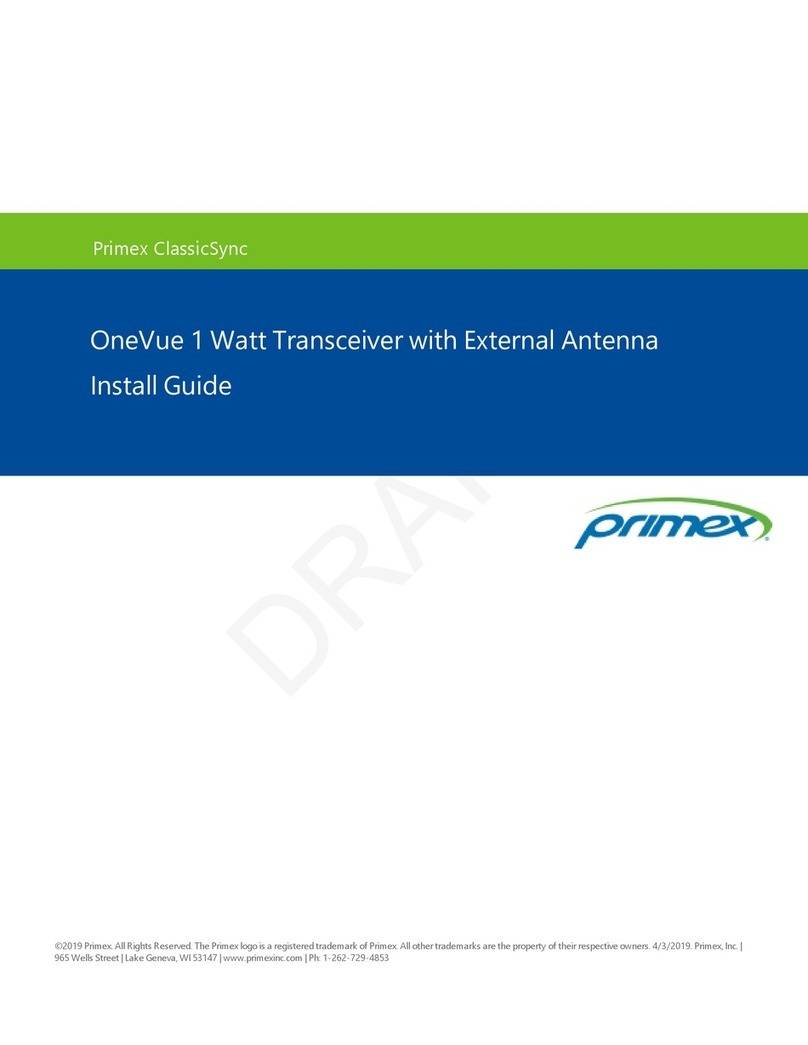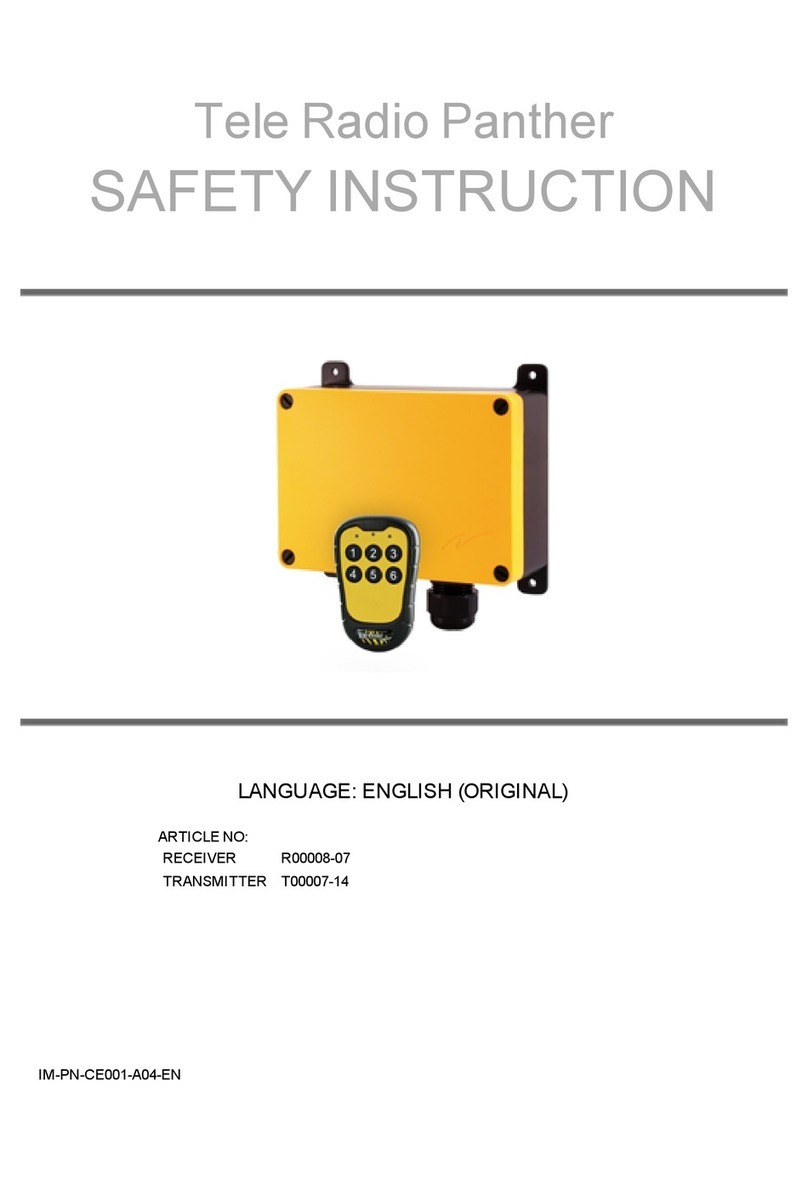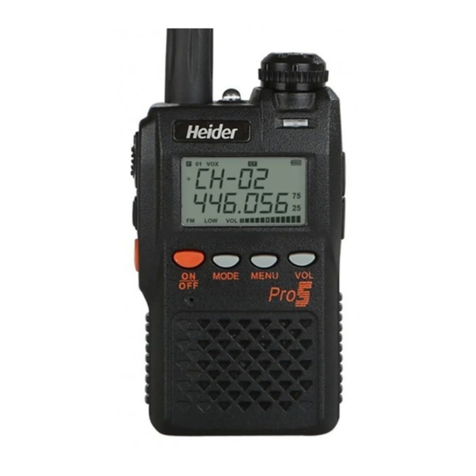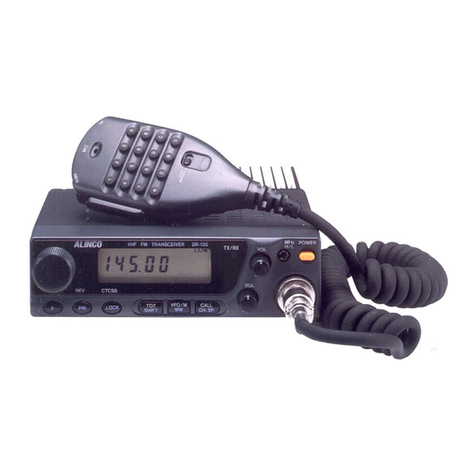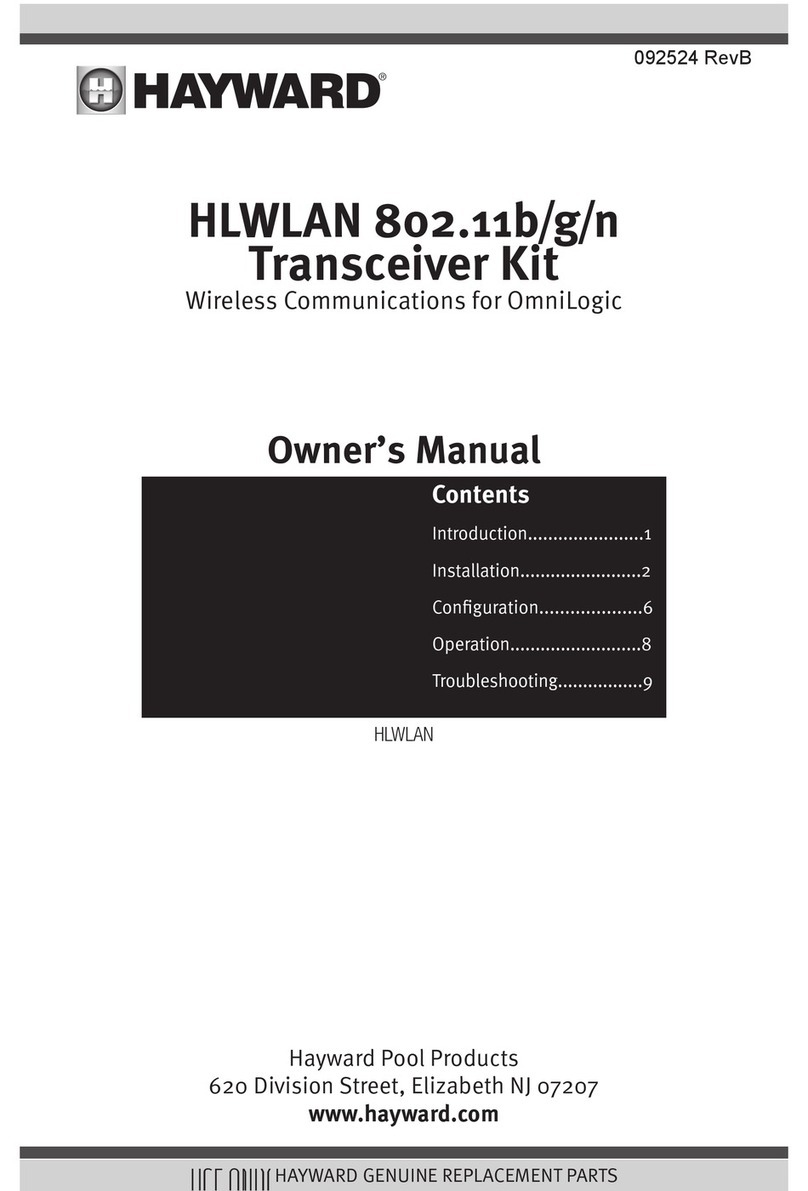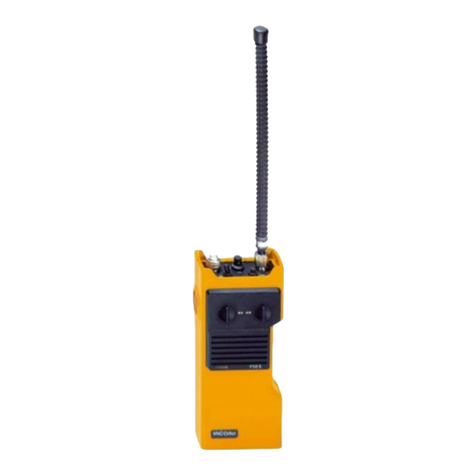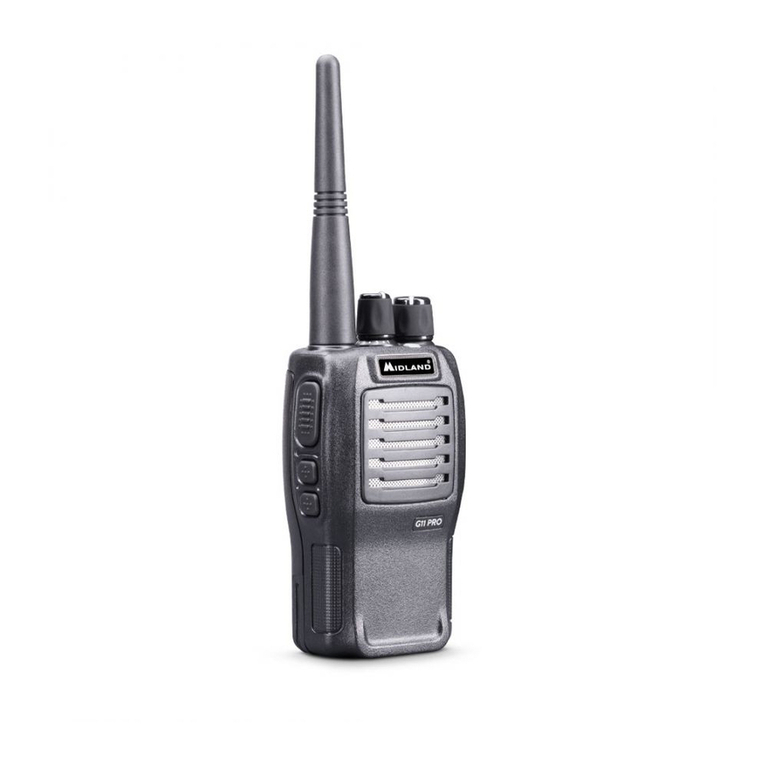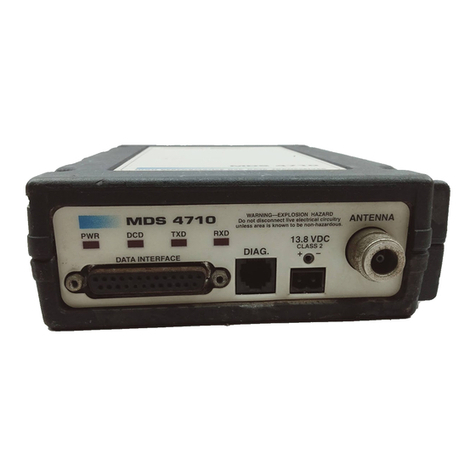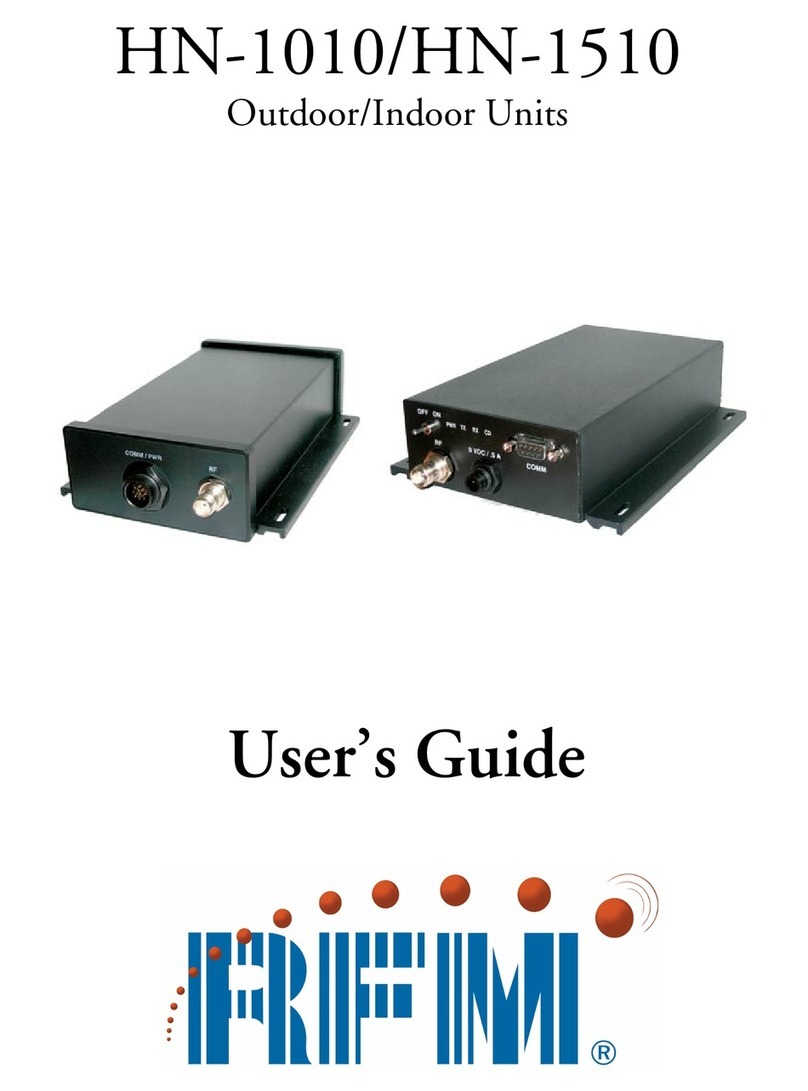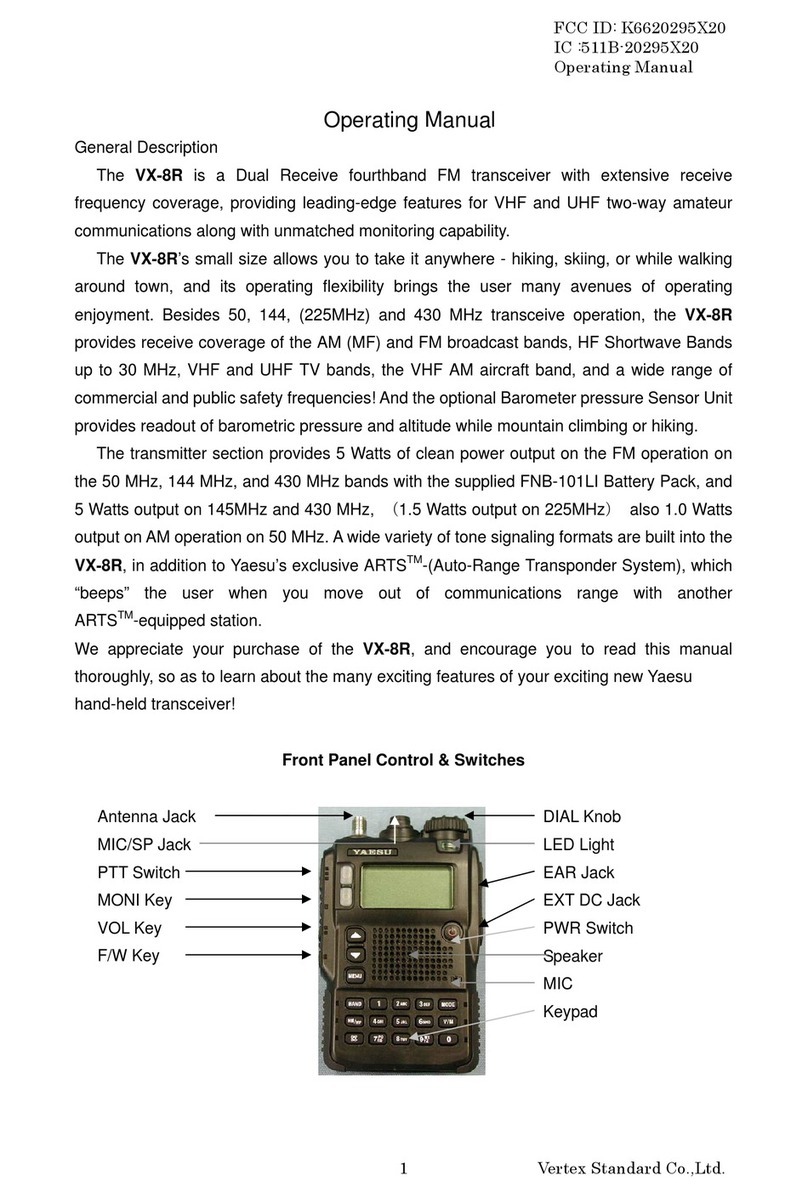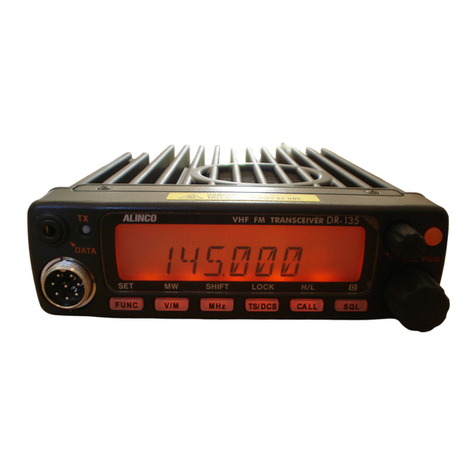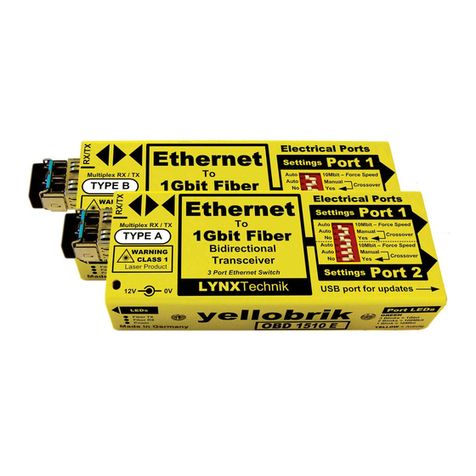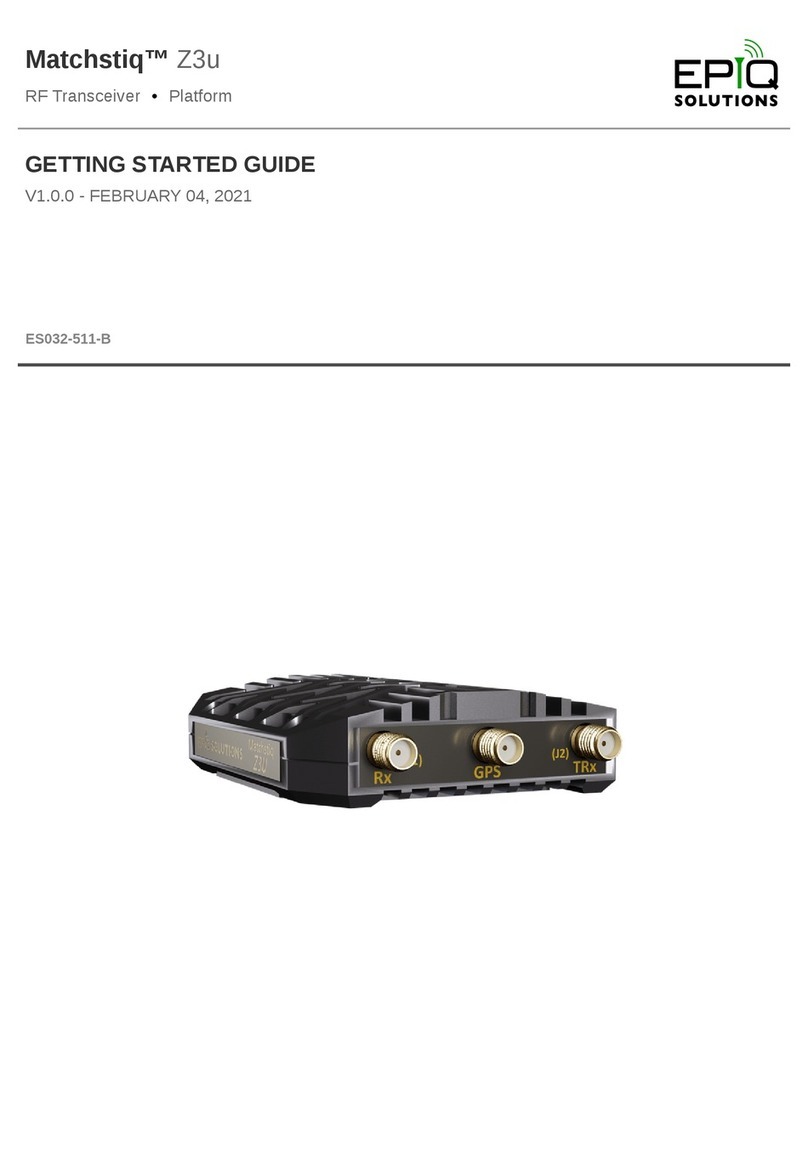Icom IC-M87 User manual

INSTRUCTION MANUAL
iM87
VHF MARINE TRANSCEIVER

i
PREFACE
Thank you for choosing this Icom product. This product is de-
signed and built with Icom’s state of the art technology and
craftsmanship.With proper care this product should provide you
with years of trouble-free operation.
IMPORTANT
READ ALL INSTRUCTIONS carefully and com-
pletely before using the transceiver.
SAVE THIS INSTRUCTION MANUAL—This
instruction manual contains important operating instructions
for the IC-M87.
EXPLICIT DEFINITIONS
WORD DEFINITION
RDANGER! Personal death, serious injury or an explo-
sion may occur.
RWARNING! Personal injury, fire hazard or electric
shock may occur.
CAUTION Equipment damage may occur.
NOTE
If disregarded, inconvenience only. No risk
of personal injury, fire or electric shock.
FEATURES
☞22 free channels for PMR use
The IC-M87 has 22 free channels reserved for PMR
use
(146–174MHz).Wide/narrow
channel spacing is program-
mable for each channel, and CTCSS and DTCS signaling
is included.
*Appropriate license will be required.
☞Tough waterproof construction
The IC-M87 is built tough to withstand hazardous and un-
hospitable environments at sea and on land. Even if the
IC-M87 is dropped into water, it’s waterproofing* will pro-
tect it from harm. The compact and durable body meets
the military specifications (MIL-STD).
* Equivalent to JIS waterproof grade 7 or IPX7 of the correspond-
ing International Standard IEC 529 (1989). (1m depth for 30
minutes)
☞Simple operation
6 clearly labelled buttons on the front panel and the vol-
ume/power knob maximize simplicity of operation. Even
when wearing gloves, the large buttons are easy to oper-
ate. A large, clear LCD with backlighting and backlit but-
tons make night time operation simple.

IN CASE OF EMERGENCY
If your vessel requires assistance, contact other vessels and
the Coast Guard by sending a distress call on Channel 16.
❍USING CHANNEL 16
DISTRESS CALL PROCEDURE
1.“MAYDAY MAYDAY MAYDAY.”
2.“THIS IS ............................” (name of vessel)
3.Your call sign or other indication of the vessel.
4.“LOCATED AT ...................... ” (your position)
5.The nature of the distress and assistance re-
quired.
6.Any other information which might facilitate
the rescue.
RECOMMENDATION
CLEAN THE TRANSCEIVER THOROUGHLY WITH FRESH
WATER after exposure to saltwater, and dry it before operat-
ing. Otherwise, the transceiver's keys, switches and control-
lers may become unusable, due to salt crystallization, and/or
the charging terminals of the battery pack may corrode.
NOTE: If the transceiver’s waterproof protection appears
defective, carefully clean it with a soft, damp (fresh water)
cloth, then dry it before operating.
The transceiver may lose its waterproof protection if the
case, jack cover, or the battery pack is cracked or broken,
or the transceiver has been dropped.
Contact your Icom distributor or your dealer for advice.
ii

iii
PRECAUTIONS
RDANGER! NEVER short terminals of the battery pack.
Shorting may occur if the terminals touch metal objects such
as a key, so be careful when placing the battery packs (or the
transceiver) in bags, and so on. Carry them so that shorting
cannot occur with metal objects. Shorting may damage not
only the battery pack, but also the transceiver.
RDANGER! NEVER use and charge Icom battery packs
with non-Icom transceivers or non-Icom chargers. Only Icom
battery packs are tested and approved for use with Icom
transceivers or charged with Icom chargers. Using third-party
or counterfeit battery packs or chargers may cause smoke,
fire, or cause the battery to burst.
RWARNING! NEVER connect the transceiver to an AC
outlet. This may pose a fire hazard or result in an electric
shock.
RWARNING! NEVER hold the transceiver so that the an-
tenna is very close to, or touching exposed parts of the body,
especially the face or eyes, while transmitting. The trans-
ceiver will perform best if the microphone is 5 to 10 cm away
from the lips and the transceiver is vertical.
CAUTION: DO NOT connect the transceiver to a power
source other than the BP-227AX. Such a connection will ruin
the transceiver.
CAUTION: DO NOT operate the transceiver unless the
flexible antenna, battery pack and jack cover are securely at-
tached. Confirm that the antenna and battery pack are dry
before attaching.Exposing the inside of the transceiver to wa-
ter will result in serious damage to the transceiver.
CAUTION: DO NOT place or leave the transceiver in direct
sunlight or in places with temperatures below –15°C or above
+55°C: Marine, below –25°C or above +55°C: PMR.
CAUTION:DONOTmodifythetransceiver.Thespecifications
may change and then the transceiver may not comply with
the requirements of required regulation. The transceiver
warranty does not cover any problems caused by unauthorized
modification.
CAUTION: DO NOT use harsh solvents such as Benzine
or alcohol when cleaning, because they will damage the
transceiver surfaces.
CAUTION: DO NOT leave the transceiver in an insecure
place to avoid use by unauthorized persons.
DO NOT push [PTT] when you do not actually intend to
transmit.
KEEP the transceiver at least 0.9 meter away from your ves-
sel’s magnetic navigation compass.

iv
Icom, Icom Inc. and Icom logo are registered trademarks of Icom Incorporated
(Japan) in Japan, the United States, United Kingdom, Germany, France, Spain,
Russia, Australia, New Zealand, and/or other countries.
PRECAUTIONS
Icom is not responsible for the destruction, damage to, or
performance of any Icom or non-Icom equipment, if the
malfunction is because of:
• Force majeure, including, but not limited to, fires, earth-
quakes, storms, floods, lightnings, or other natural disas-
ters, disturbances, riots, war, or radioactive contamination.
• The use of Icom transceiver with any equipment that is not
manufactured or approved by Icom.
BE CAREFUL! The transceiver meets IPX7* requirements
for waterproof protection. However, once the transceiver has
been dropped, waterproof protection cannot be guaranteed
because of possible damage to the transceiver's case or the
waterproof seal.
* Only when the BP-227AX, flexible antenna, [SP MIC] jack
cover is attached.
BE CAREFUL! The transceiver will become hot when
operating it continuously for long periods of time.
MAKE SURE to turn OFF the transceiver power before
connectingordisconnectingthesuppliedoroptionalaccessory.

v
INTRINSIC SAFETY
Versions of the IC-M87 which display the “EX”
marking on the serial number seal.
The approval rating for these models is II 2G Ex
ib II A T3 Gb.
WARNING! NEVER charge the BP-227AX (with/without
the transceiver) in an explosive atmosphere.The optional bat-
tery chargers are not approved as Intrinsically Safe.
When the transceiver is used in a hazardous area, the
BP-227AX MUST be attached, either the jack cover or HM-
138 MUST be attached to the speaker-microphone connec-
tor.
KEEP the transceiver and the BP-227AX clean to avoid any
risk of ignition due to the build-up of electrostatic charges.
Repair of Icom transceivers should only be carried out by
authorized Icom distributors.In particular, repair of ATEX ap-
proved transceivers can ONLY be done by Icom to main-
tain the intrinsically safe rating.NEVER attempt to repair an
ATEX approved transceivers. Only Icom has the repair exper-
tise and procedures to maintain the ATEX approval. Contact
your Icom distributor or authorised dealer for details.
The ATEX standard is described on the sticker (Ex Marking)
and BP-227AX as below.
BP-227AX
• DO NOT OPENWHEN AN EXPLOSIVE ATMOSPHERE
MAY BE PRESENT.
• DO NOT CHARGE THE BATTERY IN HAZARDOUS
LOCATION.
The equipment can be used without the microphone but
with the jack cover.

vi
The crossed-out wheeled-bin symbol on your
product, literature, or packaging reminds you that
in the European Union, all electrical and
electronic products, batteries, and accumulators
(rechargeable batteries) must be taken to
designated collection locations at the end of their
working life. Do not dispose of these products as
unsorted municipal waste. Dispose of them according to the
laws in your area.
DISPOSAL
Hereby, Icom Inc. declares that the versions
of IC-M87 which have the “CE” symbol on the
product, comply with the essential requirements
of the Radio Equipment Directive, 2014/53/EU,
and the restriction of the use of certain hazardous substances
in electrical and electronic equipment Directive, 2011/65/EU.
The full text of the EU declaration of conformity is available at
the following internet address:
http://www.icom.co.jp/world/support
The EU declaration of conformity of the ATEX Directive,
2014/34/ EU is included in the box.
ABOUT CE AND DOC

TABLE OF CONTENTS
PREFACE..............................................................................i
IMPORTANT..........................................................................i
EXPLICIT DEFINITIONS.......................................................i
FEATURES............................................................................i
IN CASE OF EMERGENCY.................................................ii
RECOMMENDATION...........................................................ii
PRECAUTIONS................................................................... iii
INTRINSIC SAFETY.............................................................v
ABOUT CE AND DOC.........................................................vi
DISPOSAL...........................................................................vi
1 OPERATING RULES.......................................................1
2 SUPPLIED ACCESSORIES AND ATTACHMENTS....2–3
3 PANEL DESCRIPTION................................................4–7
■Front, top and side panels............................................4
■Function display ...........................................................6
4 BASIC OPERATION..................................................8–12
■Channel selection.........................................................8
■Receiving and transmitting.........................................10
■Adjusting the squelch level.........................................11
■Automatic backlighting ...............................................11
■Lock function..............................................................11
■Call channel programming.........................................12
■Voice scrambler operation..........................................12
5 SCAN OPERATION.................................................13–14
■Scan types .................................................................13
■Setting TAG channels.................................................14
■Starting a scan...........................................................14
6 DUALWATCH/TRI-WATCH............................................15
■Description.................................................................15
■Operation....................................................................15
7 LAND (PMR) CHANNEL OPERATION.........................16
■LAND (PMR) Channel group.....................................16
■Function display.........................................................16
8 SET MODE ..............................................................17–21
■Set mode programming..............................................17
■Set mode items..........................................................18
9 BATTERY CHARGING............................................22–27
■Caution.......................................................................22
■AD-100 installation.....................................................26
■Optional battery chargers...........................................26
10SPEAKER-MICROPHONE............................................28
■HM-138 Description ...................................................28
■Attachments...............................................................28
11TROUBLESHOOTING...................................................29
12VHF MARINE CHANNEL LIST .....................................30
13SPECIFICATIONS.........................................................31
14OPTIONS.......................................................................32
15QUICK REFERENCE ....................................................33
16ATEX CAUTIONS....................................................35–36
INDEX...........................................................................37–39
vii

1
1
OPERATING RULES
D Priorities
• Read all rules and regulations pertaining to priorities and
keep an up-to-date copy handy. Safety and distress calls
take priority over all others.
•You must monitor Channel 16 when you are not operating
on another channel.
• False or fraudulent distress calls are prohibited under law.
D Privacy
• Information overheard but not intended for you cannot law-
fully be used in any way.
• Indecent or profane language is prohibited.
D Radio licenses
(1) SHIP STATION LICENSE
When your craft is equipped with a VHF FM transceiver, you
must have a current radio station license before using the
transceiver. It is unlawful to operate a ship station which is
not licensed.
Inquire through your dealer or the appropriate government
agency for a Ship-Radiotelephone license. This license in-
cludes the call sign which is your craft’s identification for radio
purposes.
(2) OPERATOR’S LICENSE
A restricted Radiotelephone Operator Permit is the license
most often held by small vessel radio operators when a radio
is not required for safety purposes.
The Restricted Radiotelephone Operator Permit must be
posted near the transceiver or be kept with the operator.Only
a licensed radio operator may operate a transceiver.
However, non-licensed individuals may talk over a transceiver
if a licensed operator starts, supervises, ends the call and
makes the necessary log entries.
A current copy of the applicable government rules and regu-
lations is only required to be on hand for vessels in which
a radio telephone is compulsory. However, even if you are
not required to have these on hand it is your responsibility to
be thoroughly acquainted with all pertinent rules and regula-
tions.

DSupplied accessories
The following accessories are supplied: Qty.
• Swivel belt clip ................................. 1
• Stopper for the swivel belt clip ..................... 1
• Screws for the swivel belt clip...................... 2
• Flexible antenna................................ 1
• Handstrap..................................... 1
• Battery pack................................... 1
• Power adapter*................................. 1
• Battery charger................................. 1
*Not supplied with some version
DSwivel belt clip
To attach:
qAttach the stopper to the back of the transceiver.
Supplied screws
Stopper
wClip the belt clip to a part of your belt and insert the stop-
per to the belt clip.
eOnce the transceiver is locked in place, it will swivel 360
degrees.
2
2SUPPLIED ACCESSORIES AND ATTACHMENTS

To remove:
Turn the transceiver upside down, and then lift up to release
the transceiver from the belt clip.
CAUTION:
HOLD THE TRANSCEIVER TIGHTLY, WHEN ATTACHING
OR REMOVING THE TRANSCEIVER FROM THE BELT
CLIP.
If the transceiver is accidentally dropped and the swivel
belt clip’s stopper is scratched or damaged, the swivel belt
clip may not work properly.
DFlexible antenna
Connect the supplied flexible antenna
to the antenna connector.
CAUTION:
• NEVER carry the transceiver by
holding the antenna.
• DO NOT connect the antenna
other than listed on page 32.
•Transmitting without an antenna
may damage the transceiver.
DHandstrap
Pass the handstrap through
the loop on the back side of
the transceiver as illustrated
at right.This facilitates carry-
ing.
3
2
SUPPLIED ACCESSORIES AND ATTACHMENTS

qVOLUME CONTROL [VOL]
Turns power ON and adjusts the audio level.
wANTENNA CONNECTOR (p. 3)
Connects the supplied antenna.
eSPEAKER-MICROPHONE CONNECTOR [SP MIC] (p.28)
Connects the optional speaker-microphone.
[SP MIC] jack cover
NOTE: KEEP the [SP MIC]
jack cover attached to th
e
transceiver when the speaker-
microphone is not in use.
rSCAN [SCN•DUAL]
• Starts or cancels the Normal or Priority scan. (p. 14)
• Enters watch mode when held down for 1 second. (p. 15)
tTRANSMIT POWER/LOCK SWITCH [H/L•LOCK]
• Selects high, middle (except for the German version) or
low power when pushed.(p. 10)
• Toggles the Lock function ON/OFF when held down for 1
second. (p. 11)
yCHANNEL 16 SWITCH [16•C]
• Selects Channel 16 when pushed. (p.8)
• Selects the Call channel when held down for 1 second.
(p. 8)
•
Enters the Call channel programming mode when the Call
channel is selected and this switch is held down for 3 sec-
onds. (p. 12)
■Front, top and side panels
u
r
t
i
o
!0
q
w
y
e
4
3PANEL DESCRIPTION

1-1-32 Kamiminami, Hirano-ku, Osaka 547-0003, Japan
A-6409H-1EU-12
Printed in Japan
© 2005–2018 Icom Inc.
Printed on recycled paper with soy ink.
Other manuals for IC-M87
8
Other Icom Transceiver manuals
